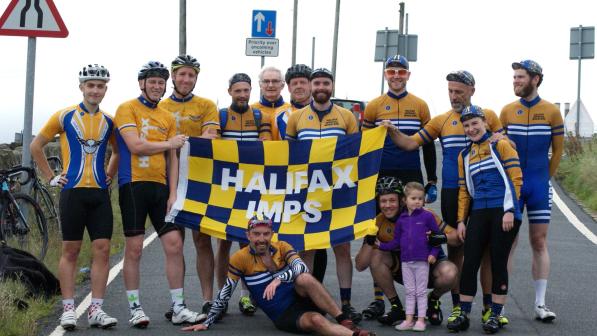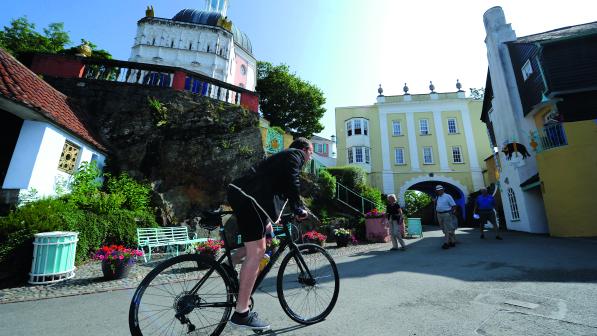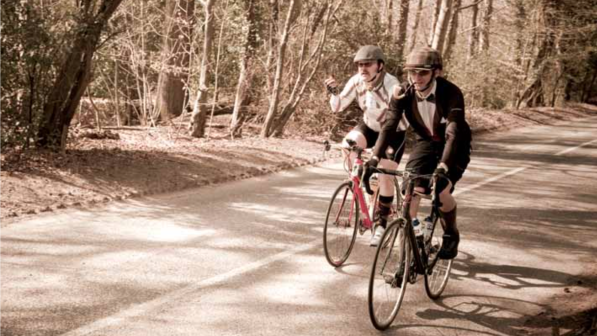A literary cycling tour in northern England

Fiction follows a formula not dissimilar to a bike ride. A beginning is required: whereby the protagonist leaves the Shire, or home, to set off on a journey of discovery. A middle: in which the plucky cyclist has to overcome a series of escalating obstacles, such as poor navigation, or the Pennines. The skills acquired along the way should then equip her for the ultimate challenge of overcoming her inability to read contours on O.S. maps. The adventurer then arrives at the end with a new outlook on life ready to share her tale.
I started my quest on the west coast near Blackpool, not because of its literary merit, but because my parents lived there. I was heading for the Trough of Bowland, the geographical centre of Great Britain. This central point also meant I was travelling into the literary world of Middle-Earth. In this surrounding area, Tolkien had visited his son who was studying to become a priest at Stonyhurst College. Legend has it Tolkien wrote some of Lord of the Rings during this time, with his hobbits populating similarly named locations such as the real life Shire Lane and the River Shirebourne.

It was a barren land with no phone signal anywhere, populated only by sheep waiting in ambush around the bottom of hairpin bends. I didn’t encounter another soul until a brew stop in Dunsop Bridge, a small haven for two-wheelers with or without engines.
I’d made good time, but an early arrival comes before a locked youth hostel. When Slaidburn’s opened at five, I was amongst a gathering band of bona-fide cyclists halfway through their own epic journeys of Lands End to John o' Groats or John o' Groats to Lands End.
The next day’s weather forecast wasn’t so favourable, and so, with Kate Bush’s Wuthering Heights on repeat in my mind, I checked my map and headed onto the wily windy back roads for what I thought was going to be a short thirty miler to Haworth: Brontë country.

I pedalled over desolate green and purple moors interspersed with cattle-grids, thinking of the strong-willed and fiercely independent Jane Eyre. Like the occasional solitary tree I passed, bent almost horizontal by relentless winds, Charlotte Brontë’s protagonist managed against all odds to remain rooted to the courage of her convictions. I considered this strength of character a lot during the first three hours it took me to cycle a measly seventeen miles. Locals bestowed me with roadside encouragement such as: "You should be riding that bike, not taking it for a walk" as I pushed it up yet another gruesome hill; and Bradley Wiggins used to train in these parts - not with fully loaded panniers he didn’t.
I emerged from the wilderness to seek refuge in Colne’s massive Sainsbury’s café. By the time I’d eaten double portions of porridge, the lunchtime menu had begun, so I stayed on for an additional recovery baked-potato. But, would Jane Eyre contemplate setting up home in a supermarket? No. She’d traipse back out into the rain, over 'them' moors, and if necessary, sleep outside fashioning a bivvy from her governess’ coat.

I swung a protesting leg over my saddle, and resumed pedalling over the savage landscapes of Cathy and Heathcliff’s Wuthering Heights. The bleak moors and craggy hillsides provided those two characters with a temporary escape until, after being driven apart by a repressive society, their intense passions twisted into a torturous obsession. That felt not unlike my torturous progression. My bike was becoming my Heathcliff.
After one last uphill, I was rewarded with Haworth’s youth hostel: Victorian Gothic mansion. This was the Brontë experience I’d been hoping for. I hauled my panniers up the dark wooden staircase, the last of the day’s light shining green through the landing’s stained-glass window. I reached the top floor and unlocked a room with a sloping ceiling. I wasn’t Jane Eyre at all. I was Bertha, the madwoman in the attic.
It was only much later, after I’d learned the art of checking a route’s profile and not just its distance that I discovered the day’s climbing had reached over three and a half thousand feet due to the Pennines being in the way. In cycling parlance, that’s an Alpe d’Huez. I gave my bike the next day off so as to visit Haworth’s Brontë Parsonage and learn more about the strong-willed three sisters who wrote stories set amongst this beautiful and dramatically wild landscape, marvelling at their determination in becoming published. In 1847, the three sisters knew publishers would be prejudiced against women authors, and so usurped the system by adopting pseudonyms. The novels were a success, allowing Currer, Ellis and Acton to out themselves as Charlotte, Emily and Anne, and ultimately into the canon of British literature.

Even after a day off the bike, I awoke with stiff and sore legs, but ‘no sooner have you got settled in a pleasant resting place, than a voice calls out to you to rise and move on’. Rallying myself with those words of encouragement from Rochester, Jane Eyre’s complicated love-interest, I resumed my uphill struggle towards Harrogate. In Otley I decided enough was enough, and headed into a café with my map, seeking local advice. I was advised to abandon the ordeal I’d mapped out in highlighter pen in favour of a more direct main road. It was longer but flatter: lesson learned. I explored Harrogate’s damp pavements, peering through the window at romantic couples in Betty's Tea Rooms, before retiring to my hotel room which I was sharing with my bike.Next up was Evelyn Waugh’s Brideshead Revisited, a novel which explores the decline of an aristocratic family set between the two world wars. I rolled along gentle hills, relieved at leaving the Pennines behind as I made the approach towards a lake set amongst landscaped fields, and in the distance peeking above the trees, the domed roof of Castle Howard.
I knew nothing of being raised in a stately home, and felt somewhat conspicuous lunching in the plush table-service café in my sweaty cycling gear. I reminded myself the novel explored an unsustainable façade beneath the seeming privilege. All of this is seen through the eyes of Charles Ryder who meets Sebastian, next in line to be Lord of the family, while they are both students at Oxford University. Out front was a grandiose fountain of Atlas bearing the weight of the world on his shoulders, faring not much better than Sebastian. In the novel, he crumbles beneath the impossible expectations placed on him which are all incompatible with his character. Inside, I admired the walls filled with Italian paintings and the Pre-Raphaelite stained glass in the chapel while contemplating the demands of the heating bill before making my way to stay in a nearby pub.
A few miles into the following day’s ride I had an all-too-near miss. A lorry overtook so closely I had the terrifying sensation of it dragging me in towards it, threatening to pull my bike under the wheels. I ended up stopping by the side of he road feeling very shaken, and then hesitantly carried on a few miles to Pickering. I stopped at a cafe to try and mentally recover and heard the puffing and whistling of a steam train. I love a steam train and so I went to investigate.
The volunteers at the North Yorkshire Moors Railway told me of its association with the TV show Heartbeat. I was a middle-aged matron (in lycra), so I fitted the fan-base but had never seen the show. Nevertheless, me, my frayed nerves and my bike made the decision to take a bit of time out and get on board.

I gazed at the countryside, admiring how the train cut through the rising green hills, meaning my legs didn’t have to, while having an internal debate about whether or not I was cheating by not riding this part of my route. The children at the table opposite whispered to each other. The voices became more insistent, turning into fevered chattering throughout the carriage. I looked over at an elder and asked him what all the kids were so excited about. He replied with two words, ‘Harry Potter.’
The train I was on was also, sort of, the Hogwarts Express. The next station was Goathland, or to give it it’s proper name in the Harry Potter films, 'Hogsmeade'. If I’m honest, I used to turn my nose up at J.K. Rowling’s novels until a friend persuaded me to just try the first one, it’s very short. I was hooked. Frantic late-night texting ensued, with me begging to borrow the next bigger volumes. Published one hundred and fifty years after the Brontë’s novels, the Harry Potter publishers insisted the author’s first name be put in initials. They argued that young boys wouldn’t read them if they knew the J belonged to a Joanne. Real life: often more ridiculous than fantasy and fiction. And now here I was, approaching the platform where Hagrid waited for Harry in the first film.
Me, my bike, and the Harry Potter and Heartbeat fans bustled around that same harbour. Everything was in blazing anti-vampire sunshine. The ruined Abbey looked magnificent on top of a very steep hill. All the way up there, next to it, was the youth hostel
Caroline Burrows
I alighted the train in Whitby in a much better mood than when I’d boarded. This next literary location also had a familial link to it. I think cycling might be in my blood. My grandad used to keep me quiet by giving me old CTC magazines to read. I’d even used the tent he’d used on his cycling tours. So, before setting off on this one, I’d told him all about my plans, especially Whitby as he had two paintings of the harbour in his living room. It was also where Bram Stoker had set some of Dracula.
My usually chirpy grandad began grumbling that Whitby was about a lot more than stupid vampires. The paintings in his house were of Captain Cook setting sail on expeditions. Not only that, Whitby was where my grandad had been billeted for some of his army training during the Second World War.
Me, my bike, and the Harry Potter and Heartbeat fans bustled around that same harbour. Everything was in blazing anti-vampire sunshine. The ruined Abbey looked magnificent on top of a very steep hill. All the way up there, next to it, was the youth hostel. I made sure to go to the Captain Cook museum, as well as the Whitby Museum which exhibited a map of locations featured in Dracula and details about the local research Bram Stoker had done.

I went in search of the Royal Crescent, the street where my grandad had been billeted over on the West Cliff. I checked the map from the museum. It was also where Mina visits Lucy in the novel, and where Bram Stoker had stayed in a hotel to write about it. From my viewpoint, I could see across the harbour, up the one hundred and ninety-nine steps on the East Cliff, to St. Mary’s church with its decrepit gravestones, in front of which, on a bench, with everything in the shadow of Whitby Abbey, Dracula bit Lucy. I duly rang my grandad to let him know where I was without mentioning any of the vampire based trivia.
The following day, my holiday was reaching its final chapter: a short pedal to Scarborough. The traffic-free Cinder Track felt a bit rough for my skinny road tyres. However, I’d been warned the main road would be busy and had lots of blind bends. It turned out I was talking to people who didn’t cycle. Never heed advice from a non-cyclist as they’ll tell you hills aren’t that hilly, and that places aren’t that far away when they’re miles off. However, this time, the advice did partly work in my favour. I got up as dawn broke to avoid the traffic, and headed on the main road, with scenes set in Scarborough from Pat Barker’s The Ghost Road. The title summed up the ride. I encountered three cars along the majestic route sweeping in and out of the coast. My parents had decided to meet me and had already stayed there overnight, driving in half a day what had taken me the best part of a week, a fact they enjoyed emphasising when I met up with them still having their breakfast on the peaceful North Bay.
I’d come to see where Billy Prior recuperated after treatment for shell shock, a fictional character whose story is woven alongside the World War One Poets, Wilfred Owen and Siegfried Sassoon. But, no sooner had me and my parents stepped out for a stroll than I was pedalling away from them having seen a map of historical blue plaques. I stood in a small car park, my bike lent against the wall of the slightly faded Clifton hotel. Wilfred Owen had written poetry there in 1917, before returning to France where he was killed one week before the Armistice.

The faded seaside resort was taking on a depressing tone. Anne Brontë came here hoping that the sea air would help her recover from tuberculosis. I found the plaque on the site where she’d died in 1848, and her grave in yet another church called St. Mary’s.
But Scarborough wasn’t going to let me finish on a downer. There was one more plaque where Charles Laughton was born near the train station. He’d helped adapt and starred in the English version of Bertolt Brecht’s Life of Galileo. Set during the seventeenth century, the Roman Inquisition were not best pleased with Galileo scientifically proving the earth, and therefore the Church, wasn’t at the centre of the universe with everything revolving around them. The play’s message was about the importance of not blindly accepting what you were told, but instead going out into the world to see things with your own eyes. This is what reading all of these books had led me to do on my bike tour, taking me from the pages of different literary worlds set in many different times, out on my own mini adventure amongst the real life landscapes of the North of England. I couldn’t have asked for a better ending.
Do it yourself
As an alternative starting point, I’d recommend getting the train to Lancaster which makes the Forest and Trough of Bowland quickly and easily accessible. Preston is another option for starting the route from, however, it’s quite a busy city to get in and out of. At the end I got the train home from Scarborough.






